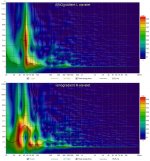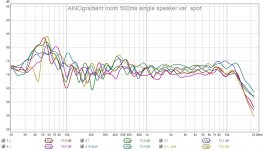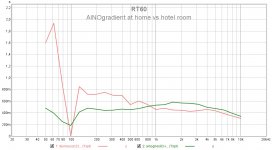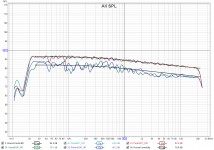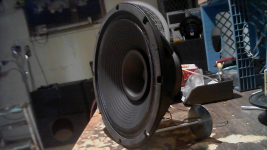Argh, you are making this so difficult! Perhaps after 10y anniversary of Ainos I might make dipole bass units... only 2 years 'till that!
I think you should explore dipole bass. Your speaker positioning will work fine. The improvement in clarity compared to sealed is not subtle.
Argh, you are making this so difficult! Perhaps after 10y anniversary of Ainos I might make dipole bass units... only 2 years 'till that!
You currently crossover from your dipole woofer to your sealed subwoofers around 200Hz (IIRC). All you need to do in order to get more benefits of dipole bass is choose a different woofer that will allow you to reach to 100Hz or (better) below, e.g. 80Hz, at which point you can cross over to a sealed subwoofer and have more freedom of placement of that subwoofer in the room. The extra octave and a half of dipole bass should bring some new and better thing to your system.
For example, I use an Eminence Deltalite 2515 in such a role. It can work down to about 80Hz nude (100Hz if you want really loud SPLs).
You would not need to make drastic changes to your existing system. Think about giving it a try!
Dipole bass below 60-80 Hz is sort of room dependent - larger rooms work better. So if your listening space is not "large" I would still implement the bottom end using a closed box subwoofer.
Last edited:
OK guys, please remember that I get cardioid response 100-200Hz and of course I have tried xo around 100Hz. The 12" woofer is a PA unit with only moderate Xmax. Some people praise cardioid bass over anything in audio world! I have been very happy with my system, it works really well with movies, jazz, classical, choirs and pop (perhaps even rock but I don't listen to it)
My living room is very open and asymmetrical, has RT around 0.4 and I even don't eq modes (naturally I have tested that)! But OK, I'm getting more and more interested in testing dipole bass! I could swap AINO boxes to 2x15" like LX521 easily, and use old boxes as subs (my Minidsp 4x10HD has those SW channels free) And I have a powerful NHT Power2 2x200W classD amp in reserve...
My living room is very open and asymmetrical, has RT around 0.4 and I even don't eq modes (naturally I have tested that)! But OK, I'm getting more and more interested in testing dipole bass! I could swap AINO boxes to 2x15" like LX521 easily, and use old boxes as subs (my Minidsp 4x10HD has those SW channels free) And I have a powerful NHT Power2 2x200W classD amp in reserve...
Attachments
Last edited:
For your consideration: GR Research sells a kit of dipole subs based on Rythmik servo subs using a Rythmik plate amp and 1, 2, or 3x 12" drivers per amp optimized for dipole use. A user at Audiogon uses them xo at 180Hz (with dipole speakers) and says they can go up to 300Hz. Another user (who is a professional classical bass player) also spoke highly about the GR OB subs with dipole speakers.
I have 2 Rythmik subs in DIY sealed boxes crossing over to naked 18" at 65Hz. Bass texture is outstanding and I've been wondering what the upside of dipole subs below 65Hz might be, especially because I have the same plate amps that are used for OB subs. Maybe add two additional sealed subs for a distributed bass array below 65Hz (to get more even bass response across the room), or turn to 2 dipole subs, or mix 2 sealed and 2 OB...
From the comments above it seems there would be limited upside to go OB below 65Hz vs staying sealed, correct? Would love to read your views.
I have 2 Rythmik subs in DIY sealed boxes crossing over to naked 18" at 65Hz. Bass texture is outstanding and I've been wondering what the upside of dipole subs below 65Hz might be, especially because I have the same plate amps that are used for OB subs. Maybe add two additional sealed subs for a distributed bass array below 65Hz (to get more even bass response across the room), or turn to 2 dipole subs, or mix 2 sealed and 2 OB...
From the comments above it seems there would be limited upside to go OB below 65Hz vs staying sealed, correct? Would love to read your views.
Completely agree, the resolution and clarity in bass area is really improved from boxed bass. Well, earlier I have had only reflex bass/sub boxes, not sealed so that can make some difference. 1x Delta15LFA in u-frame (stereo) is loud enough for apartment with lousy sound isolation, but below 50Hz even I would recommend separate closed sub.I think you should explore dipole bass. Your speaker positioning will work fine. The improvement in clarity compared to sealed is not subtle.
For your consideration: GR Research sells a kit of dipole subs based on Rythmik servo subs using a Rythmik plate amp and 1, 2, or 3x 12" drivers per amp optimized for dipole use.
Flat OB bass down to 20Hz.... this I have to experience one day!
This is not very difficult on moderate SPL levels.Flat OB bass down to 20Hz.... this I have to experience one day!
I had it with Selenium 18" on 300mm U-frame. On image 2 versions DSP IIR and PC FIR filters measured at listening position.
Attachments
Last edited:
When you connect both drivers are they simply in parallel? I think 6dB gain is from combo of double the area and half the impedance. This is usual benefit of taking two 8ohm driver in parallel for 4ohm. 6dB gain for same drive voltage.
I am already there man! 🙂
Just listening to the 8in GRS with a 15uF cap and my 8in woofer - man it sounds incredible. That’s a sweet tweeter!
I'm most impressed with your HP calculator. Wish I could find mine!
This is not very difficult on moderate SPL levels.
I had it with Selenium 18" on 300mm U-frame. On image 2 versions DSP IIR and PC FIR filters measured at listening position.
FWIW, I used to have a REL sub that reached to 20Hz and was a ported design. I replaced with Rythmik sealed with servo, and while it reached as low as REL it sounded better. I bought the rationale of servo (and sealed) being more controlled, despite both extending equally low. And purchased 2 kits for the price of one REL 😉
GR Research also talks about how servo in dipole subs makes a difference. They even have an informative video on their website. I haven't heard this one, though.
I'm most impressed with your HP calculator. Wish I could find mine!
Thanks! I couldn’t live without my HP32S II! This is the best scientific RPN, IMO. I even have an app that is a clone of it for my iPhone when I am not at my desk. 🙂 I must use it at least 10x a day.
About 10 years ago after 20 years of service, the screen and buttons stopped working. I searched online and people wanted like $375 for a used one. I finally pried it apart to fix the polyurethane foam that rotted. They use foam to apply pressure for the flexible circuit board to contact the screen and the main PCB. When the foam rots (and polyurethane always does) it loses contact pressure. I replaced with melamine foam which won’t rot and now it works good as new. And I have my calculator back again.
Now back to the regular programming. 🙂
This is not very difficult on moderate SPL levels.
I had it with Selenium 18" on 300mm U-frame. On image 2 versions DSP IIR and PC FIR filters measured at listening position.
In a small (smallish) room, sure.
My listening room is quite big and opened. To get close to a meaningful 20Hz, I would need a lot of cone surface (more like a wall of cones!) that would just not pass WAF.
I do get sub 20Hz, but only when the army helos pass over the house at about 300m high. That shakes the whole house... it's just not the same thing! 😀
I agree, I don't think this is anything other than two subwoofers summing as one and therefore we are seeing a 6dB rise.
If I took the two of them and put them side by side, we would see exactly the same summing and 6dB rise in output.
All this confirms is that having them in this clamshell configuration doesn't hinder that summing process.
More interesting to me is the slight reduction in distortion, which can only be explained by the clamshell orientation I think.
To me this is simply a nice way to save space and sling the drivers to prevent mechanical vibrations transmitting to the baffle.
It is exactly as linkwitz describes here:
Electro-acoustic models
I'm really curious about the advantages of the clamshell arrangement. Could this be used higher in frequency as well? Apart from the aesthetics there could be some interesting opportunities... There will be shading from basket and magnet of course, but other than that? Any ideas?
For me the only reason to use this arrangement is to get the VD of four high excursion 15" subs in as small a package as possible.
The hammock sling/suspended arrangement is also a great boon, but I don't think I would want high excursion subs playing much higher than 100Hz to be honest and in the freq range 100-600hz, you don't need high VD so I can't see a place for the clamshell set up.
So for me - I would really only use this arrangement for sub duty.
The hammock sling/suspended arrangement is also a great boon, but I don't think I would want high excursion subs playing much higher than 100Hz to be honest and in the freq range 100-600hz, you don't need high VD so I can't see a place for the clamshell set up.
So for me - I would really only use this arrangement for sub duty.
there is no point to use dipole bass bellow first room mode which is going to happen at lambda=2L (L=largest room dimension). Bellow that frequency (for 5mx5m - 34Hz) room behave as compression chamber and has 6dB/octave gain toward lower frequencies. That is nice virtue when sealed sub used, making equalization easier and asking less power.
Box of course should be sturdy and heavy but that shouldn't be a problem
Box of course should be sturdy and heavy but that shouldn't be a problem
with good sub positioning is easy reachable half or even octave higher with very smooth response.
I prefer corner because from there sub excite all room mods in operating frequency range and with equalization smooth the peaks
I prefer corner because from there sub excite all room mods in operating frequency range and with equalization smooth the peaks
there is no point to use dipole bass bellow first room mode which is going to happen at lambda=2L (L=largest room dimension). Bellow that frequency (for 5mx5m - 34Hz) room behave as compression chamber and has 6dB/octave gain toward lower frequencies. That is nice virtue when sealed sub used, making equalization easier and asking less power.
Box of course should be sturdy and heavy but that shouldn't be a problem
Turns out my room has a mode at 35Hz, which even after extensive trapping with helmholtz resonators is still having an impact. And the DIY sealed boxes weight 100lbs without driver and amp -heavy.So you are saying bass between 20 and 35Hz with dipoles won't be better than sealed. But what about 35Hz to 70 or 80Hz? More content is expected to be in the latter range.
I think the discussion is more about bass texture and quality rather than extension.
PS: I need to include a picture of my HP28S!
I, as well, prefer texture and definition, but is nice to have extension as well.
As you, guys, started to discuss using dipole for lowest frequencies I just gave my 5 cents about it.
Using dipole for lowest frequencies is hard to achieve, almost impossible in any sane size of speakers. As already mentioned, for octave lower and same SPL monopole need 4 times excursion. When add natural dipole roll-off there is 6 dB more to compensate what is giving 8 times so it is very easy to run out excursion, not to mention rise of distortion with so long membrane moving.
Dipole bass due to its response interact with room much less than monopole and that is very convenient in modal region as giving more flat and even response. But bellow first room mode there is no modes any more and room response is straight line with 6dB/octave gain so why not to use that opportunity in relative cheap and easy way.
Anyway there is no much texture on those low frequencies, usually is just UMPH, and yes, with critically damped sealed sub is very tight and defined. In half octave above first mode is usually only one peak which is easy to tame by EQ. Texture and snappiness coming above 50-60 Hz and there OB will overtake.
It is just about using the most economical and apropriate way regarding acoustical properties of the room through the hear able frequency range.
Of course, everybody will find what is best for him.
As you, guys, started to discuss using dipole for lowest frequencies I just gave my 5 cents about it.
Using dipole for lowest frequencies is hard to achieve, almost impossible in any sane size of speakers. As already mentioned, for octave lower and same SPL monopole need 4 times excursion. When add natural dipole roll-off there is 6 dB more to compensate what is giving 8 times so it is very easy to run out excursion, not to mention rise of distortion with so long membrane moving.
Dipole bass due to its response interact with room much less than monopole and that is very convenient in modal region as giving more flat and even response. But bellow first room mode there is no modes any more and room response is straight line with 6dB/octave gain so why not to use that opportunity in relative cheap and easy way.
Anyway there is no much texture on those low frequencies, usually is just UMPH, and yes, with critically damped sealed sub is very tight and defined. In half octave above first mode is usually only one peak which is easy to tame by EQ. Texture and snappiness coming above 50-60 Hz and there OB will overtake.
It is just about using the most economical and apropriate way regarding acoustical properties of the room through the hear able frequency range.
Of course, everybody will find what is best for him.
It is just about using the most economical and apropriate way regarding acoustical properties of the room through the hear able frequency range.
Of course, everybody will find what is best for him.
Completely agree!
I am lucky - with the 4x 15" subs I have (Combined VD well over 6 litres!) I can hit OB bass to my lowest room mode - 30Hz without running out of excursion or high distortion.
However - my previous monopoles hit below 20 flat, so I am missing some of the the 20-30Hz region....
At the moment the bass just seems better in all metrics for music - but I have no doubt for films, surround sound etc - I will not be moving to open baffle subs! (Unless I have a wall of subwoofers!😀)
Wow Erik! What a lot of impressive builds! You are clearly almost as mad as me!!!
Don't you just love this journey!?
Hi Bushmeister,
just remembered this post of you! Indeed, quite some builds and experience accumulated. I spent a lot of time on amplifiers, but at a certain moment there was barely any perceived difference between them, so I started dealing with the speakers. Now that I think I have a very revealing system I am going back to the amplifiers.
Also, with a line array it is close to impossible to try out a different speaker, so there is little temptation, still... for the slims there is no substitute, for the woofers there are some, but the investment would be more than 2000 USD, so first need to get some cash 🙂
best regards,
Erik
- Home
- Loudspeakers
- Multi-Way
- The 'Circles of Doom’... Open baffleless full range speakers
